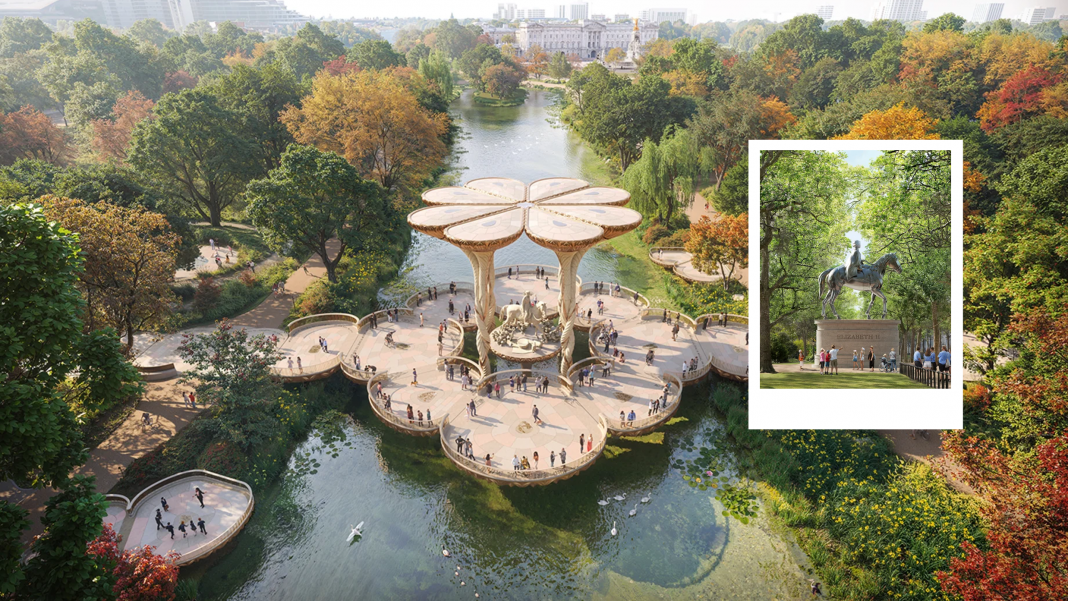Bridges of memory: Five visionary designs unveiled for Queen Elizabeth II’s London memorial
The legacy of Queen Elizabeth II — Britain’s longest-reigning monarch and a symbol of continuity through the 20th and 21st centuries is one step closer to a permanent presence in the heart of London. Five shortlisted designs for her official national memorial were unveiled this week, revealing a rich tapestry of architectural imagination and symbolic storytelling. Set to be located in St. James’s Park, near Buckingham Palace, the memorial will not only honor the late Queen’s extraordinary life of service but also offer a public space for reflection, gathering, and quiet beauty. The designs come from some of the UK’s most acclaimed architects and landscape designers, with the final selection to be announced this summer. The completed memorial is expected to be unveiled in 2026, marking what would have been Queen Elizabeth II’s 100th birthday.

A place of beauty, remembrance, and public meaning
The Queen Elizabeth Memorial Committee established jointly by the British government and the Royal Household — set an ambitious brief: to create “an emotionally powerful place” that evokes Elizabeth II’s values of service, duty, and resilience. Committee chair Lord Janvrin, her former private secretary, emphasized that the space should offer “a place to visit with friends, a place to gather, to enjoy, and to reflect on an extraordinary life.”
The public is also invited to be part of the decision-making process. The five designs are currently featured in an online exhibition, with public feedback open until May 19.

A bridge of togetherness
One of the most visually poetic proposals comes from Heatherwick Studio, led by celebrated designer Thomas Heatherwick. At the heart of their vision is a sweeping limestone bridge adorned with sculptural lilies — a literal “Bridge of Togetherness” meant to symbolize the Queen’s ability to unify across generations and geographies.
Seventy carved “lily pads” laid along the path represent each year of her reign, while plants and flowers with personal significance to the Queen are interwoven into the landscape. A subtle statue of Her Majesty sits beneath the protective canopy of the lilies. “Like her legacy, it is quietly monumental,” the proposal states. “A memorial grown from the landscape, open to people throughout the world from every walk of life.”

Gardens of harmony and historical echoes
In another high-profile entry, Foster + Partners takes inspiration from John Nash’s 19th-century transformation of St. James’s Park. The proposal interlaces lush gardens and winding pathways, anchored by a “Unity Bridge” designed to reflect the Queen’s role in connecting people and institutions from the Commonwealth to the Armed Forces.
The memorial’s paths will bear engraved quotations from key moments of Elizabeth II’s reign, including words from her 1953 coronation: “Throughout all my life and with all my heart I shall strive to be worthy of your trust.” Sculptural elements include new statues of the Queen and Prince Philip, as well as a kinetic “Wind Sculpture” by Yinka Shonibare, conceived as a focal point for shared experience and contemplation.

The Queen as the nation’s bedrock
For J&L Gibbons, the Queen’s constancy through turbulent times inspired a concept grounded quite literally in geological symbolism. Their design features a bridge constructed of bedrock, metaphorically connecting to Elizabeth II’s role as the nation’s foundation.
Their landscape invites “forest bathing” in peaceful glades and emphasizes tranquility and introspection. A quote from the Queen’s 1966 Christmas broadcast — in which she spoke of bringing “gentleness and care into the harsh progress of mankind” — anchors the emotional tone of the design.

Nature’s memory: The Queen’s oak
Renowned horticulturist and landscape architect Tom Stuart-Smith offers perhaps the most poignant centerpiece: a full-scale bronze casting of a centuries-old oak tree from Windsor Great Park, once part of the royal family’s private estate. Called “The Queen’s Oak,” the sculpture would shimmer over the lake like a “golden mirage” at night, reflecting Elizabeth II’s deep connection to nature and heritage.
Surrounding this focal point, bronze flowers from Commonwealth nations and a curated “sonic soundscape” featuring personal recordings from citizens touched by the Queen’s reign add layers of meaning and memory.
Threads of a life
Lastly, WilkinsonEyre, known for their recent restoration of Battersea Power Station, offers a more abstract and conceptual vision. Their proposal weaves together seven symbolic “threads” — including themes such as family, duty, nature, and the Commonwealth — to guide visitors through different zones of the memorial, representing the Queen’s seven decades of service.
Dual bridges at varying heights will offer panoramic views of London’s landmarks while giving physical form to the intertwining aspects of the Queen’s life. The result is intended to be a multi-sensory journey of contemplation and discovery.
A monarch remembered, a space reimagined
Each of the five shortlisted designs brings a distinct voice to the shared goal of remembering Queen Elizabeth II — not just as a head of state, but as a figure of stability, empathy, and human connection. Whether through metaphorical bridges, living gardens, or sculptural grandeur, the proposals speak to a national — and international — longing for spaces that honor legacy while inspiring future generations.
As the public weighs in and the final decision approaches, one thing is clear: Queen Elizabeth II’s memorial will not merely commemorate a historic reign, but will become a living part of the city’s fabric — a place where memory, meaning, and nature converge.



